- Clone
- 2G1-K12 (See other available formats)
- Regulatory Status
- RUO
- Other Names
- IL-21 Receptor, novel interleukin receptor (NILR)
- Isotype
- Mouse IgG1, κ
- Ave. Rating
- Submit a Review
- Product Citations
- publications
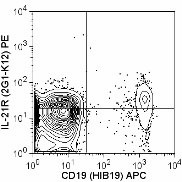
-

Human peripheral blood lymphocytes were cultured overnight with (bottom) or without (top) recombinant human IL-21, then surface stained with purified 2G1-K12 conjugated to PE and CD19 APC -

Human peripheral blood lymphocytes were cultured overnight with (bottom) or without (top) recombinant human IL-21, then surface stained with purified 2G1-K12 conjugated to PE and CD19 APC
| Cat # | Size | Price | Quantity Check Availability | Save | ||
|---|---|---|---|---|---|---|
| 347802 | 100 µg | 212€ | ||||
The human interleukin 21 receptor (IL-21R), is a single pass type I membrane protein and a member of the type I cytokine receptor family. Of the type I cytokine receptors, IL-21R exhibits the greatest extracellular homology to the IL-2R beta subunit, i.e., contains one copy of the WSXWS-containing cytokine-binding domain. Intracellular domains of IL-21R include the Box 1 and Box 2 elements which are similar to the IL-9R intracellular region. Upon binding IL-21, the IL-21R forms a heterodimer with the common gamma subunit (CD132) and induces Jak/Stat signaling. IL-21R is expressed on B cells and at various levels on NK and T cells. IL-21 is a potent immunomodulatory cytokine mainly produced by NKT and CD4 T-cells (particularly the inflammatory Th17 subset) and has pleiotropic effects on both innate and adaptive immune responses. These actions include positive effects such as enhanced proliferation of natural killer (NK) cells and cytotoxic T cells that can destroy virally infected or cancerous cells and direct inhibitory effects on the antigen-presenting function of dendritic cells. It can also be proapoptotic for B cells and NK cells. Recent studies have shown that IL-21 is also an autocrine cytokine that potently induces Th17 differentiation and suppresses Foxp3 expression, and serves as a target for treating inflammatory diseases.
Product DetailsProduct Details
- Verified Reactivity
- Human, Cynomolgus, Rhesus
- Reported Reactivity
- African Green, Baboon
- Antibody Type
- Monoclonal
- Host Species
- Mouse
- Immunogen
- IL-21R transfected Ba/F3 cells
- Formulation
- Phosphate-buffered solution, pH 7.2, containing 0.09% sodium azide.
- Preparation
- The antibody was purified by affinity chromatography.
- Concentration
- 0.5 mg/ml
- Storage & Handling
- The antibody solution should be stored undiluted between 2°C and 8°C.
- Application
-
FC - Quality tested
- Recommended Usage
-
Each lot of this antibody is quality control tested by immunofluorescent staining with flow cytometric analysis. For flow cytometric staining, the suggested use of this reagent is ≤ 2.0 µg per 106 cells in 100 µl volume. It is recommended that the reagent be titrated for optimal performance for each application.
-
Application References
(PubMed link indicates BioLegend citation) -
- Rodrigues-Bayona B, et al. 2012. J. Immunol. 188:1578. PubMed
- RRID
-
AB_2044031 (BioLegend Cat. No. 347802)
Antigen Details
- Structure
- Single pass type I membrane protein, extracellular WSXWS-containing cytokine-binding domain, intracellular Box1 and Box2 domains
- Distribution
-
B cells, various levels on NK cells and T cells
- Ligand/Receptor
- IL-21
- Cell Type
- B cells, NK cells, T cells, Tregs
- Biology Area
- Immunology, Innate Immunity
- Molecular Family
- CD Molecules, Cytokine/Chemokine Receptors
- Antigen References
-
1. Parish-Novak J, et al. 2000. Nature 408:57.
2. Ozaki K, et al. 2000. Proc Natl. Acad. Sci. USA. 97:11439.
3. Dumoutier L, et al. 2000. Proc Natl. Acad. Sci. USA. 97:10144.
4. Asao H, et al. 2001. J. Immunol. 167:1.
5. Parish-Novak J, et al. 2002. J. Leukocyte Biol. 72:856.
6. de Torero D, et al. 2006. Blood 107:3708.
7. Davis ID, et al.2007. Clin Cancer Res. 13:6926.
8. Nurieva R, et al. 2007. Nature 448:4416. - Gene ID
- 50615 View all products for this Gene ID
- UniProt
- View information about CD360 on UniProt.org
Related FAQs
Other Formats
View All CD360 Reagents Request Custom Conjugation| Description | Clone | Applications |
|---|---|---|
| Purified anti-human CD360 (IL-21R) | 2G1-K12 | FC |
| PE anti-human CD360 (IL-21R) | 2G1-K12 | FC |
| APC anti-human CD360 (IL-21R) | 2G1-K12 | FC |
| Brilliant Violet 421™ anti-human CD360 (IL-21R) | 2G1-K12 | FC |
Customers Also Purchased
Compare Data Across All Formats
This data display is provided for general comparisons between formats.
Your actual data may vary due to variations in samples, target cells, instruments and their settings, staining conditions, and other factors.
If you need assistance with selecting the best format contact our expert technical support team.
-
Purified anti-human CD360 (IL-21R)
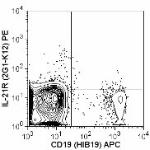
Human peripheral blood lymphocytes were cultured overnight w... 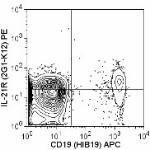
Human peripheral blood lymphocytes were cultured overnight w... -
PE anti-human CD360 (IL-21R)
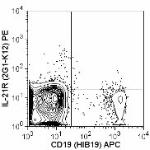
Human peripheral blood lymphocytes were cultured overnight w... 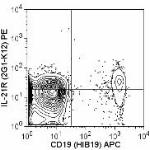
Human peripheral blood lymphocytes were cultured overnight w... -
APC anti-human CD360 (IL-21R)
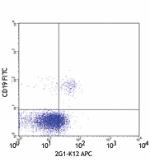
Human peripheral blood lymphocytes stained with CD19 FITC an... 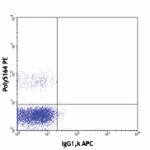
-
Brilliant Violet 421™ anti-human CD360 (IL-21R)
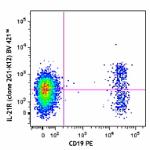
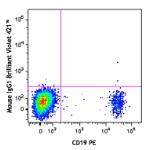
 Login / Register
Login / Register 






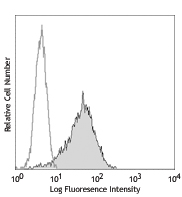
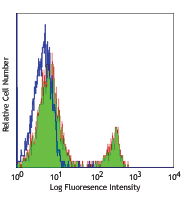
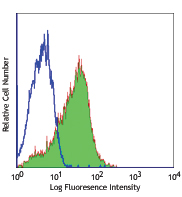



Follow Us